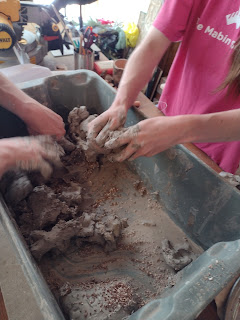Building the Bronze Clay Furnace
Here she be: the primitive bronze furnace!
It's not quite the same dimensions as detailed in the Asmus article which we were following, basically because we ran out of clay. It's about 34 cm high, 45 cm wide at the bottom and 28 cm at the top, with an opening of 16 cm. There are three openings below which are 10 x 6 cm, as per Asmus' design.
It took two sessions to build it, but really only about 4 hours of total work time, once we had nearly all the crushed up grog to work with, and the rehydrated clay.
And I wrote myself a little note with a phrase I have never written or uttered before:
The Principle that we were studying that month in my community of Silo's Message is the Principle of Acceptance that says: "If day and night, summer and winter are well with you, you have overcome the contradictions."
And as I watered the furnace, I thought about opposites like day and night, summer and winter... and water and furnaces (not exactly opposites, but you get the idea). And I thought about that mental and emotional attitude that allows you to see opposites as not opposed to each other but instead as part of a larger whole. And I thought about how much richer one's experience of reality can be when one connects with that attitude.
So I started going over some of the "opposites" involved in making this clay furnace:
To produce a hard, dry material that will maintain incredible heat, the clay must first be moist.
To make the furnace stronger, more resistant to cracks, we need to add to it "impurities", like smashed-up brick and ceramic.
To increase its insulating qualities, we need to add to it combustible material like straw or dry grass that will burn away to create empty spaces which retain heat.
Dry and wet, strong and broken, emptiness and retention... our little furnace is already a wonder of unified "opposites".
Next time, we meet we'll fire it up and see how it all comes together.














wonderful! thanks.
ReplyDelete